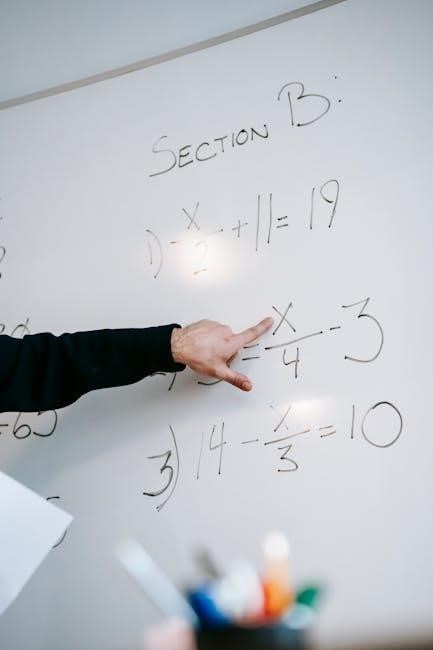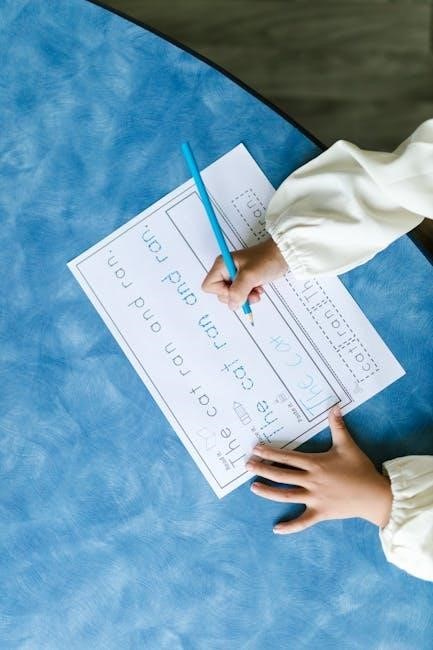Mastering the skill of subtracting fractions with unlike denominators is essential for building strong mathematical foundations. This process involves finding a common denominator, converting fractions, and performing subtraction. Various worksheets are available to practice this concept, catering to different grade levels and learning needs, ensuring comprehensive understanding and proficiency.

What Are Unlike Denominators?
Unlike denominators refer to the different bottom numbers in two or more fractions, indicating that the fractions are divided into unequal parts. For example, in the fractions 1/2 and 1/3, the denominators 2 and 3 are unlike. When subtracting such fractions, it is necessary to find a common denominator to make the fractions comparable. This process involves identifying the least common denominator (LCD) and converting the fractions accordingly. Understanding and working with unlike denominators is a fundamental skill in fraction operations, as it allows for accurate subtraction and real-world applications.
Why Subtracting Fractions with Unlike Denominators is Important
Subtracting fractions with unlike denominators is a critical skill that builds a strong foundation in mathematics. It enhances problem-solving abilities and prepares students for more complex operations like algebra and geometry. In real-world scenarios, such as cooking, construction, or budgeting, fractions are essential for precise measurements and calculations; Mastering this concept ensures accuracy in dividing resources, scaling recipes, or completing DIY projects. Additionally, it fosters logical reasoning and adaptability in handling diverse numerical challenges. Regular practice with worksheets and PDF resources helps students confidently apply this skill in various situations, making it a vital part of their educational journey.

Steps to Subtract Fractions with Unlike Denominators
Subtracting fractions with unlike denominators involves four key steps: finding the least common denominator (LCD), converting fractions, subtracting numerators, and simplifying the result. Worksheets and PDF resources provide structured practice for mastering this process.
Finding the Least Common Denominator (LCD)
The first step in subtracting fractions with unlike denominators is finding the least common denominator (LCD). The LCD is the smallest number that both denominators can divide into evenly. To find the LCD, list the multiples of each denominator until you find the smallest common multiple. For example, for denominators 4 and 6, the multiples of 4 are 4, 8, 12, 16, and the multiples of 6 are 6, 12, 18. The smallest common multiple is 12, so the LCD is 12. Worksheets often include exercises to practice this step, ensuring mastery before moving on to fraction conversion.
Converting Fractions to Have the Same Denominator
Once the LCD is identified, the next step is to convert each fraction to an equivalent fraction with the LCD as the denominator. To do this, multiply both the numerator and the denominator of each fraction by the same number to reach the LCD. For example, if the LCD is 12 and the fraction is 1/4, multiply both the numerator and denominator by 3 to get 3/12. This step ensures that both fractions have the same denominator, making subtraction straightforward. Worksheets often include exercises to practice this conversion process, covering proper fractions, improper fractions, and mixed numbers.
Subtracting the Numerators
After converting the fractions to have the same denominator, subtract the numerators while keeping the denominator unchanged. For example, if you have 7/12 and 5/12, subtract 5 from 7 to get 2/12. This step is straightforward once the fractions are aligned with the same denominator. Ensure the result is in its simplest form by checking if the numerator and denominator have any common factors. Worksheets often include problems that focus solely on this step to reinforce the concept, helping students build confidence in their subtraction skills. Proper practice ensures accuracy and speed.
Simplifying the Result (if needed)
After subtracting the numerators, it’s crucial to simplify the resulting fraction if possible. Simplification ensures the fraction is in its lowest terms, making it easier to understand and work with in further calculations. For instance, if the result is 4/8, divide both the numerator and the denominator by their greatest common divisor, which is 4, to get 1/2. Worksheets often include exercises that focus on simplifying fractions, providing ample practice for students to master this essential skill. Regular practice helps build proficiency and reduces errors in mathematical operations.


Types of Fractions Involved in Subtraction
Subtraction involves proper fractions, improper fractions, and mixed numbers. These fractions often have different denominators, requiring conversion to like fractions before performing the operation. Worksheets provide ample practice opportunities.

Proper Fractions
A proper fraction is one where the numerator is smaller than the denominator, such as 3/4 or 1/2. When subtracting proper fractions with unlike denominators, the process involves finding a common denominator, converting the fractions, and then subtracting the numerators. Worksheets provide ample practice for this, ensuring students master the concept. Proper fractions are foundational in understanding more complex fraction operations, making them a crucial focus in math education.
Improper Fractions
An improper fraction has a numerator greater than or equal to the denominator, such as 5/3 or 7/4. Subtracting improper fractions with unlike denominators requires finding a common denominator, converting each fraction, and then subtracting. Worksheets dedicated to this topic provide varied exercises, helping students grasp the method. These exercises often include simplifying the result, reinforcing skills in handling different fraction types. Improper fractions are a step toward understanding mixed numbers and more complex fraction operations, making them a vital part of math curriculum. Regular practice ensures fluency in these essential skills.
Mixed Numbers
A mixed number combines a whole number and a proper fraction, such as 1 1/2 or 2 3/4. Subtracting mixed numbers with unlike denominators involves converting them to improper fractions, finding a common denominator, and then subtracting. Worksheets often include problems where students convert, subtract, and simplify results, enhancing their understanding of complex fraction operations. These exercises are designed to build confidence and fluency in handling multiple fraction types, preparing students for advanced math concepts. Regular practice with mixed numbers ensures a solid foundation in fraction subtraction skills.
Practice Resources for Subtracting Fractions with Unlike Denominators
Printable PDF worksheets are widely available, offering exercises for subtracting fractions with unlike denominators. These resources include answer keys and cater to various skill levels, ensuring comprehensive practice.
Printable Worksheets in PDF Format
Printable PDF worksheets are an excellent resource for practicing the subtraction of fractions with unlike denominators. These worksheets are designed for various grade levels, including grades 4 and 5, and cover a range of difficulties. Many worksheets include exercises on subtracting proper fractions, improper fractions, and mixed numbers with different denominators. They often come with detailed answer keys, allowing students to check their work and understand their mistakes. These PDF files are easy to download and print, making them a convenient tool for homework or classwork. By using these resources, students can build confidence and fluency in subtracting fractions with unlike denominators.
Online Tools and Websites
Several websites offer valuable resources for practicing the subtraction of fractions with unlike denominators. Platforms like Super Teacher Worksheets and K5 Learning provide comprehensive tools and guides. These sites feature interactive exercises, step-by-step instructions, and printable worksheets tailored for different skill levels. Additionally, websites such as EffortlessMath.com offer detailed lessons and practice materials, including answer keys for self-assessment. These online tools are ideal for students seeking to master fraction subtraction in a structured and engaging manner. They also cater to various learning styles, ensuring a well-rounded educational experience.

Common Mistakes to Avoid
When subtracting fractions with unlike denominators, common errors include incorrectly calculating the least common denominator and forgetting to simplify the final result. Always double-check calculations.
Incorrect Calculation of the LCD
One common mistake when subtracting fractions with unlike denominators is incorrectly calculating the least common denominator (LCD). The LCD is the smallest number that both denominators can divide into evenly. For example, if the denominators are 4 and 6, the LCD is 12, not 8 or 18. If the LCD is miscalculated, the resulting fractions will not be equivalent to the originals, leading to incorrect subtraction results. Always list the multiples of each denominator to ensure the LCD is accurate. This step is crucial for maintaining the integrity of the fractions during the subtraction process.
Forgetting to Simplify the Result

Another common error when subtracting fractions with unlike denominators is neglecting to simplify the final result. After performing the subtraction, the fraction obtained may not be in its simplest form. For instance, if the result is ( rac{4}{8} ), it should be reduced to ( rac{1}{2} ). Failing to simplify can lead to incorrect or misleading answers, as the fraction does not represent its smallest possible terms. Always check if the numerator and denominator have a common divisor greater than 1 and divide both by this number to simplify properly. This ensures accuracy and clarity in the solution.

Real-World Applications of Subtracting Fractions with Unlike Denominators
Subtracting fractions with unlike denominators is a valuable skill with numerous practical applications. In cooking and baking, adjusting recipe measurements often requires subtracting fractions with different denominators. For example, scaling down ingredients for a smaller batch of cookies involves such calculations. Similarly, in construction and woodworking, subtracting fractions is essential for precise material measurements. It also applies in finance when calculating budget adjustments or comparing expenses. Additionally, in gardening, determining the correct amounts of seeds or fertilizers may involve subtracting fractions with unlike denominators. This skill enhances problem-solving abilities in everyday life, making it a fundamental math concept.

